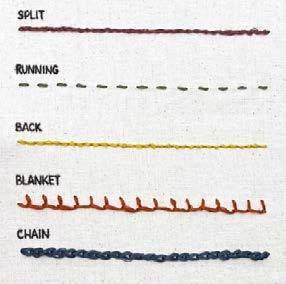
3 minute read
8 Logo Mania
TIME
1.5 hours
Advertisement
Objective
The objective of this activity is to give participants handson experience with handwork related to textiles, so they can understand the principles and value of hand-made clothing.
Description
Participants design their own simple logo on paper, which they then try to embroider on a piece of prepared clothing or textile. As an alternative they can paint on the logo.
Topics
Value of human labour
Tools
Embroidery hoops, threads and needles
Scissors
Paper and pencils
Own piece of clothing or other textile
Textile paint as an alternative
Activity
This activity should be led by an educator/professional who is experienced in handwork with tools and understands health and safety precautions. This activity is carried out by the participants working on their own.
At the start, ask them the following questions:
Can you imagine the effort and time it takes to create a garment, its parts, embroidery, a textile etc.?
Have you ever tried to fasten a button? Fix a hole? Do you have any experience with embroidery?
If a piece of clothing is damaged (e.g. if it tears or there is a hole), what do you do with such clothing next? Throw it out / repair it yourself / give it to someone else to help you with its repair? the embroidery hoop and instruct them to draw a draft of their logo (max. 5x5 cm) on their designated spot on the stretched fabric with a marker or pencil. They can then choose threads and needles with which they will embroider their logo in the time available.
Give each participant a piece of paper and ask them to draw their own logo design within 15 minutes. There are no limits to their imagination, but you should emphasise that the whole activity should take a minimum of 1.5 hours. A more complex logo will take longer to embroider.
Next, ask the participants to show their logos and explain the meanings behind their design (if they want to).
Next, ask them to consider where they wish to place that logo on their item of clothing or textile. Encourage them to be creative with their placement. Explain to them that this is their way of customising their own clothing. They can make a statement which will stay on it.
Introduce to participants the rules of a safe practice when using sharp objectsneedles, scissors, etc.
Show them how to put a piece of their clothing or textile in
Tell them that they can use following stitches:
What could you have done better? What would you say is successful about your logo?
What did you realise while working on this activity? What did you learn?
Do you think the work of a garment worker is difficult? (sewers, knitters, weavers, embroiders, printers etc.).
Photo credit: https://www.hgtv.ca/easy-stitcheshand-embroidery-beginners/

After they have finished embroidering their logos, ask them the following questions:
What is the story of your logo? What does it mean?
Did you have enough time to complete your embroidery?
How would you describe the final quality of your work?
Are you satisfied with your embroidered logo?
What are the challenges of these professions / crafts? Can you imagine embroidering, for example, 8 hours a day without a break, like lots of fashion and textiles workers in third world countries?
Can you imagine having your own clothing brand? What would the clothes you would make look like?
Methodology Tips
• The educator will ideally know basic embroidery techniques (stitches, working with an embroidery hoop).
• Try to source materials and thread as responsibly as possible. Use yarns and threads that you already have at home or that you can get from family members or friends.
• Have participants share images of their logo embroidery on their social networks. You can also create a common hashtag related to this activity.

• Instead of embroidery you can suggest painting a logo on the clothing or textile This can be easier for younger participants to do.
Tips For Online
Participants can design logos on their computers, with the help of a software they know how to use - Corel Paint, Adobe Photoshop or Illustrator, etc.
It also might be helpful to use online embroidery tutorials that you can familiarise the participants with before the activity. With the online version of the activity, you can send the embroidery hoops, needles and threads to individual participants at their addresses.
9 TIME




